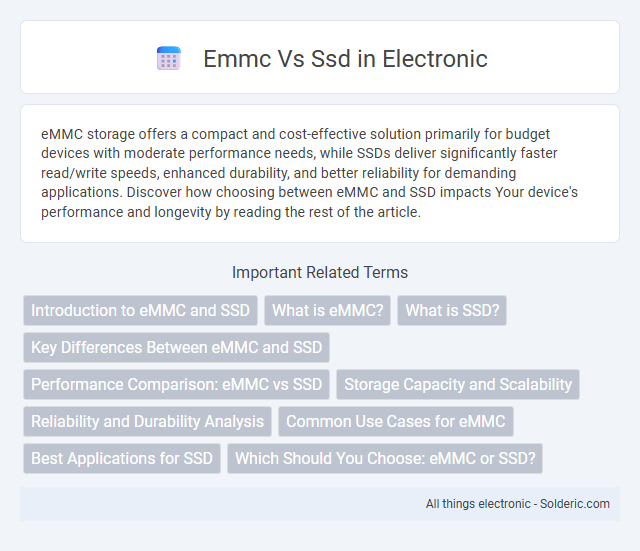eMMC storage offers a compact and cost-effective solution primarily for budget devices with moderate performance needs, while SSDs deliver significantly faster read/write speeds, enhanced durability, and better reliability for demanding applications. Discover how choosing between eMMC and SSD impacts Your device's performance and longevity by reading the rest of the article.
Comparison Table
| Feature | eMMC | SSD |
|---|---|---|
| Storage Type | Embedded MultiMediaCard (Flash Storage) | Solid State Drive (Flash Storage) |
| Speed | 100-400 MB/s (Sequential Read/Write) | 500 MB/s to 7,000 MB/s (Sequential Read/Write, NVMe SSD) |
| Interface | eMMC Interface | SATA, NVMe (PCIe) |
| Form Factor | Small, Embedded on Motherboard | 2.5", M.2, PCIe Card |
| Durability | Moderate | High (Better Endurance) |
| Price | Lower Cost | Higher Cost |
| Use Case | Smartphones, Tablets, Budget Laptops | Desktops, High-Performance Laptops, Servers |
| Lifespan | Lower (Limited Write Cycles) | Higher (Advanced Wear-Leveling) |
Introduction to eMMC and SSD
eMMC (embedded MultiMediaCard) is a type of flash storage commonly used in budget smartphones, tablets, and entry-level laptops, offering a compact and cost-effective solution with moderate read/write speeds. SSD (Solid State Drive) provides faster data access, higher durability, and greater storage capacity, making it the preferred choice for performance-driven devices like gaming PCs and professional workstations. The key distinction lies in eMMC's integration on the motherboard versus SSD's modular design, allowing easier upgrades and better performance scalability.
What is eMMC?
eMMC (embedded MultiMediaCard) is a type of internal storage commonly used in smartphones, tablets, and budget laptops, integrating flash memory and a controller on a single chip. It offers cost-effective storage with moderate speed and durability, making it suitable for everyday tasks but less performant compared to SSDs. Unlike SSDs, eMMC lacks advanced features like wear leveling and faster data transfer rates, impacting its efficiency in high-demand computing environments.
What is SSD?
SSD (Solid State Drive) is a storage device that uses NAND-based flash memory to store data, offering faster read and write speeds compared to traditional eMMC (embedded MultiMediaCard) storage. Unlike eMMC, which is often soldered onto a device's motherboard and used in budget or mobile devices, SSDs provide higher durability, better performance, and are commonly found in laptops, desktops, and enterprise environments. SSD technology significantly improves system responsiveness, boot times, and file transfer rates due to its lack of moving parts and advanced controller mechanisms.
Key Differences Between eMMC and SSD
eMMC (embedded MultiMediaCard) offers slower data transfer speeds and lower durability compared to SSD (Solid State Drive), which provides faster read/write performance and enhanced reliability for demanding applications. SSDs utilize NAND flash memory with advanced controllers that enable higher endurance and better efficiency, making them ideal for intensive use cases in laptops and desktops. You should consider SSDs for improved speed and longevity, while eMMC is suitable for budget-friendly, lightweight devices with less intensive storage needs.
Performance Comparison: eMMC vs SSD
SSD offers significantly faster read and write speeds compared to eMMC, with typical SSDs reaching up to 500 MB/s or higher, whereas eMMC speeds usually max out around 250 MB/s. SSDs provide better random access times and durability due to advanced controllers and wear-leveling technologies, enhancing overall system responsiveness and reliability. eMMC is more suited for budget devices with moderate performance needs, while SSDs are ideal for demanding applications requiring quick data transfer and intensive multitasking.
Storage Capacity and Scalability
eMMC storage typically ranges from 32GB to 128GB, offering limited scalability due to its fixed storage capacity embedded on the device. SSDs provide significantly higher storage options, from 128GB up to several terabytes, allowing easy upgrades or replacements to meet growing data demands. Choosing an SSD can future-proof Your device with scalable storage solutions, while eMMC suits basic, low-capacity needs without the option for expansion.
Reliability and Durability Analysis
eMMC storage typically offers lower reliability and durability compared to SSDs due to its limited write cycles and simpler error correction mechanisms. SSDs utilize advanced wear-leveling algorithms and robust error-correcting code (ECC), significantly enhancing lifespan and data integrity under heavy workloads. Enterprise-grade SSDs can endure terabytes written (TBW) values that are multiple times higher than eMMC, making them more suitable for intensive read/write operations and prolonged use.
Common Use Cases for eMMC
eMMC storage is commonly found in budget-friendly laptops, tablets, and smartphones due to its cost-effectiveness and compact design, making it suitable for everyday tasks like web browsing, media consumption, and light productivity. It offers sufficient performance for booting operating systems and running basic applications but lacks the speed and endurance required for intensive workloads or heavy multitasking. Your choice of eMMC is ideal if you need affordable, low-power storage with moderate read/write requirements rather than the high performance offered by SSDs.
Best Applications for SSD
SSDs excel in high-performance computing, gaming, and professional content creation due to their superior read/write speeds and lower latency compared to eMMC. They are ideal for operating systems, software development, and applications requiring rapid data access and multitasking capabilities. SSDs also enhance overall system responsiveness and durability in laptops, desktops, and enterprise servers.
Which Should You Choose: eMMC or SSD?
Choosing between eMMC and SSD depends largely on your device's performance needs and budget. SSDs offer significantly faster read/write speeds, better durability, and enhanced multitasking capabilities, making them ideal for gaming, video editing, and professional work. eMMC storage suits basic tasks like browsing and light app usage in budget laptops or tablets, where cost-efficiency and lower power consumption are prioritized.
emmc vs ssd Infographic

 solderic.com
solderic.com